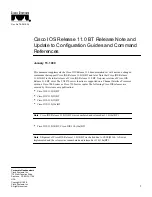
Creating numbering plans
207
Programming Operations Guide
Incoming calls:
If your system is networked with other systems, you will also need to determine a
private access code that tells your system when a call is to be dialed out over the private network
instead of over the public network. This access code is also entered under
Services, Telephony
Services, General settings, Access codes.
This code is included as part of any destination code or
dialing sequence that is to be routed over the private network.
MCDN special call types: If your system is networked to other types of systems, such as
Meridian 1, which sends calls through one or more Business Communications Manager systems to
the public network, you need to specify specific call-type codes. These codes append to the
incoming dial string, so that the call-type remains intact as it passes through the Business
Communications Manager call processing:
Calls coming in over private networks or PRI/BRI lines can either terminate at one telephone,
called the prime telephone, or target lines can be set up for each telephone or group of telephones
to which the calls are directed. As with other incoming calls, these calls can have a public or
private call type that matches to a public or private received number assigned to a target line.
Outgoing calls:
Other network codes include the information about private and public dialing
codes that you enter under
Services, Telephony Services, General settings, Dialing Plans
Variable
Example or default settings
Private Access Code
6
Variable
Example or default settings
Local Access Code
9
Coordinate these settings with Meridian
routing for these calls types and the Private
Access Code.
National Access Code
61
Special Access Code
911
Variable
Example or default settings
Private received number
<CDP: same as DN of telephone>
<UDP: LOC code + DN>
Public received number
<North America: 10 digits XXX-XXX-XXXX, the trailing digits are the DN>
<DPNSS: maximum number of digits in local dialing pattern>
Variable
Example or default settings
Private network ID
Number that identifies the system as part of the private network
Location code
UPD networks
Private DN length
DPNSS systems only
Public DN lengths (prefixes)
Public dialing table
Summary of Contents for BCM 3.7
Page 4: ...4 Software licensing N0008589 3 3...
Page 32: ...32 Contents N0008589 3 3 W 937 Index 939...
Page 46: ...46 Tables N0008589 3 3...
Page 64: ...64 How to get help N0008589 3 3...
Page 90: ...90 Manually activating Telnet N0008589 3 3...
Page 116: ...116 Delayed system restart N0008589 3 3...
Page 194: ...194 Configuring a data module N0008589 3 3...
Page 276: ...276 Setting line telco features N0008589 3 3...
Page 310: ...310 Using COS passwords N0008589 3 3...
Page 364: ...364 Enhanced 911 E911 configuration N0008589 3 3...
Page 380: ...380 Renumbering DNs N0008589 3 3...
Page 398: ...398 Saving wizard pages on your computer N0008589 3 3...
Page 458: ...458 Voice Mail settings N0008589 3 3...
Page 488: ...488 Setting system telco features N0008589 3 3...
Page 508: ...508 Other programming that affects public networking N0008589 3 3...
Page 522: ...522 PRI networking using Call by Call services N0008589 3 3...
Page 592: ...592 Monitoring Hunt groups N0008589 3 3...
Page 636: ...636 Configuring Double Density N0008589 3 3...
Page 640: ...640 Using the Network Update Wizard N0008589 3 3...
Page 666: ...666 Importing and Exporting DHCP data N0008589 3 3...
Page 722: ...722 Restarting the router N0008589 3 3...
Page 726: ...726 Important Web Cache considerations N0008589 3 3...
Page 748: ...748 Configuring an Interface with NAT N0008589 3 3...
Page 794: ...794 IPSec N0008589 3 3...
Page 818: ...818 Configuring the Policy Agent characteristics N0008589 3 3...
Page 832: ...832 Firewall rules for Business Communications Manager with Dialup interfaces N0008589 3 3...
Page 876: ...876 ISDN Programming N0008589 3 3...
Page 1004: ...1004 Index N0008589 3 3...
















































